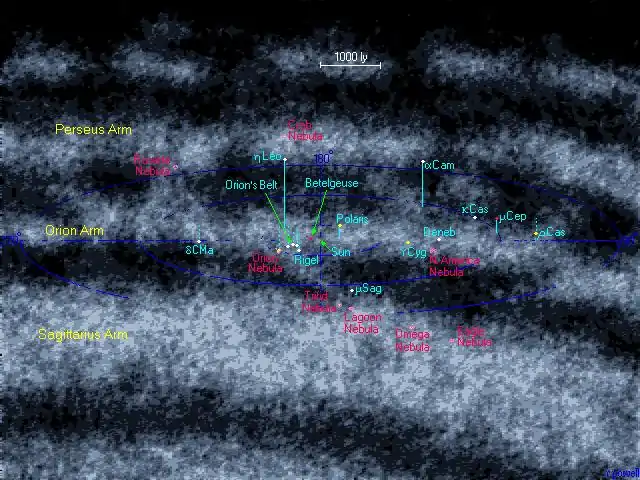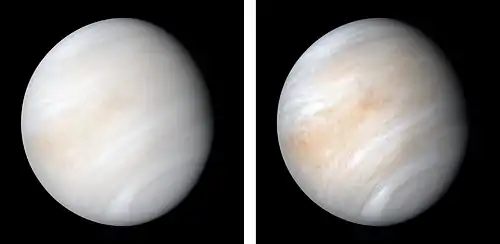Radcliffe wave
The Radcliffe wave is the nearest coherent gaseous structure in the Milky Way, dotted with a related high concentration of interconnected stellar nurseries. It stretches about 8,800 light years.[1][2] It runs with the trajectory of the Milky Way arms, and lies at its closest (the Taurus Molecular Cloud) at around 400 light-years and at its farthest about 5000 light-years (the Cygnus X star complex) from the Sun, always within the Local Arm (Orion Arm) itself, spanning about 40% of its length and on average 20% of its width.[3][4] Its discovery was announced in January 2020 and its proximity surprised astronomers.[1][5]
Formation

Scientists do not know how the undulation of dust and gas formed; it has been suggested that it could be a result of a much smaller galaxy colliding with the Milky Way, leaving behind "ripples", or could be related to dark matter.[1][6] Inside the dense clouds, gas can be so compressed that new stars are born;[2] it has been suggested that this may be where the Sun originated.[1]
Many of the star-forming regions found in the Radcliffe wave were thought to be part of a similar-sized but somewhat helio-centric ring in which sat our solar system, "the Gould Belt". It is now understood the nearest, discrete, relative concentration of sparse interstellar matter instead forms a massive wave.[1][2]
Discovery
The wave was discovered by an international team of astronomers including Catherine Zucker and João Alves.[7][4] It was announced by co-author Alyssa A. Goodman at the 235th meeting of the American Astronomical Society, held at Honolulu[8] and published in the journal Nature on 7 January 2020.[9] The discovery was made using data collected by the European Space Agency's Gaia space observatory.[10] The wave was invisible in 2D, requiring new 3D techniques of mapping interstellar matter to reveal its pattern.[2][10][8] The proximity of the wave surprised astronomers.[1][5] It is named after the Radcliffe Institute for Advanced Study in Cambridge, Massachusetts, the place of study of the team.[10]
Overview
The Radcliffe wave contains four of the five Gould Belt clouds, the:
The cloud not within its scope is the Rho Ophiuchi Cloud complex, part of a parallel, linear structure to the Radcliffe wave.
Other structures in the wave, further from the local star system, are Canis Major OB1, the North America Nebula and Cygnus X.[4]
The mass of this structure is on the scale of M☉. It has a length of 8.8 kilolight-years (2.7 kpc) and an amplitude of 520 light-years (160 parsec). The Radcliffe wave occupies about 20% of the width and 40% of the length of the local arm (Orion Arm). The latter is more dispersed as to its interstellar medium than the wave and has further, large, star-forming regions such as Monoceros OB1, California Nebula, Cepheus Far, and Rho Ophiuchi.[4]
See also
- Antlia 2, another giant ripple across the Milky Way's disc found in data from the Gaia space telescope
- List of nearby stellar associations and moving groups
References
- "Astronomers discover huge gaseous wave holding Milky Way's newest stars". The Guardian. 7 January 2020. ISSN 0261-3077. Retrieved 7 January 2020.
- Rincon, Paul (7 January 2020). "Vast 'star nursery' region found in our galaxy". BBC News. Retrieved 7 January 2020.
- Brandon, Specktor (7 January 2020). "Mysterious 'Wave' of Star-Forming Gas May Be the Largest Structure in the Galaxy". livescience.com. Retrieved 7 January 2020.
- Alves, João; Zucker, Catherine; Goodman, Alyssa A.; Speagle, Joshua S.; Meingast, Stefan; Robitaille, Thomas; Finkbeiner, Douglas P.; Schlafly, Edward F.; Green, Gregory M. (January 2020). "A Galactic-scale gas wave in the Solar Neighborhood". Nature. 578 (7794): 237–239. arXiv:2001.08748. Bibcode:2020Natur.578..237A. doi:10.1038/s41586-019-1874-z. PMID 31910431.
- Osborne, Hannah (7 January 2020). "Something appears to have collided with the Milky Way and created a huge wave in the galactic plane". Newsweek.
- "Something Appears to Have Collided with the Milky Way and Created a Huge Wave in the Galactic Plane". Radcliffe Institute for Advanced Study at Harvard University. 8 January 2020. Retrieved 9 January 2020.
- McIntosh, Bennett (7 January 2020). "An Interstellar Ribbon of Clouds in the Sun's Backyard". Harvard Magazine. Retrieved 7 January 2020.
- Strickland, Ashley. "Astronomers discover giant wave-shaped structure in the Milky Way". CNN. Retrieved 7 January 2020.
- "New map of Milky Way reveals giant wave of stellar nurseries". Phys.org. Retrieved 7 January 2020.
- Dunn, Marcia (8 January 2020). "Titanic wave of star-forming gases found in Milky Way". Associated Press. ISSN 0447-5763. Retrieved 8 January 2020 – via Japan Times Online.
External links
- Alves, João; Zucker, Catherine; Goodman, Alyssa A.; Speagle, Joshua S.; Meingast, Stefan; Robitaille, Thomas; Finkbeiner, Douglas P.; Schlafly, Edward F.; Green, Gregory M. (2020). "A Galactic-scale gas wave in the solar neighborhood". Nature. 578 (7794): 237–239. arXiv:2001.08748. Bibcode:2020Natur.578..237A. doi:10.1038/s41586-019-1874-z. PMID 31910431.
- Interactive map of the Radcliffe wave on the sky
- The Radcliffe Wave informational site created by Harvard University


_on_Jul_14_2020_aligned_to_stars.jpg.webp)